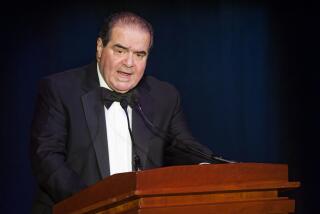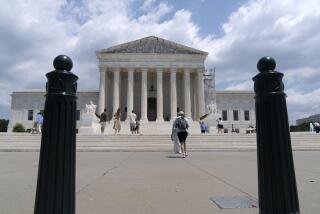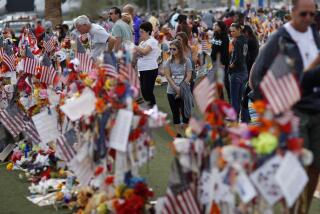Editorial: The Supreme Court strikes down a dress code for voters
Itās usually risky to predict how the Supreme Court will rule based on oral arguments in a case. But the justices seemed to show their hand last February when they considered a challenge to a Minnesota law that says voters canāt wear āpolitical insigniaā at a polling place ā a law challenged by a voter who had been asked to remove or cover up his tea party T-shirt.
The lawyer for the state told the court that while a shirt displaying the slogan āParkland Strongā would be permissible, a shirt with the logo of the National Rifle Assn. would not. Similarly a shirt displaying the text of the 1st Amendment would be allowed, while one displaying the text of the 2nd Amendment ācould be viewed as political.ā Justice Neil Gorsuch noted that this interpretation āwould forbid people from wearing certain portions of the Bill of Rights into a polling place but not other portions of the Bill of Rights.ā
As the justices threw out other examples of clothing with possible political connotations ā rainbow shirts, an AFL-CIO shirt ā it became clear that Minnesotaās ban was so broad that it gave local election officials endless leeway in deciding what was permissible and what was not.
Sure enough, on Thursday the court correctly concluded that such vagueness violated the free-speech protections of the 1st Amendment and it struck down the law. But it could ā and should ā have gone even further in affirming free speech at polling places.
Enter the Fray: First takes on the news of the minute from L.A. Times Opinion Ā»
Writing for a seven-justice majority, Chief Justice John G. Roberts Jr. said that Minnesota had failed to āarticulate some sensible basis for distinguishing what may come in from what must stay out.ā That, he noted, created a problem for the election officials who have to enforce the ban on āpoliticalā clothing.
āWe do not doubt that the vast majority of election judges strive to enforce the statute in an evenhanded manner, nor that some degree of discretion in this setting is necessary,ā he wrote. āBut that discretion must be guided by objective, workable standards. Without them, an election judgeās own politics may shape his views on what counts as āpolitical.ā And if voters experience or witness episodes of unfair or inconsistent enforcement of the ban, the stateās interest in maintaining a polling place free of distraction and disruption would be undermined by the very measure intended to further it.ā
But Roberts suggested that restrictions on narrower categories of political speech might pass constitutional muster because polling places are ānonpublic forumsā where limitations on speech are permissible so long as they are reasonable. He approvingly cited Californiaās restrictions on clothing that includes the display of a candidateās name or a ballot measureās number or title.
Certainly those restrictions are clearer and less onerous than a vague restriction like Minnesotaās vague ban on āpoliticalā clothing, campaign buttons and baseball caps. But they also restrict free speech and put election officials in the position of policing a dress code. And if the goal is to maximize turnout, telling voters that their clothing will be scrutinized when they show up sends a mixed message that might discourage at least a few from turning out.
Even at a polling place authorities ought to allow voters to wear clothing expressing their point of view ā even about the election ā so long as they donāt accost their fellow voters or attempt to proselytize or hand out literature. That strikes us as a more reasonable way to balance self-expression and the stateās interest in an orderly election process.
Follow the Opinion section on Twitter @latimesopinionand Facebook
More to Read
A cure for the common opinion
Get thought-provoking perspectives with our weekly newsletter.
You may occasionally receive promotional content from the Los Angeles Times.










